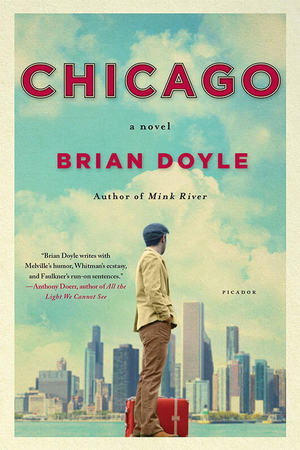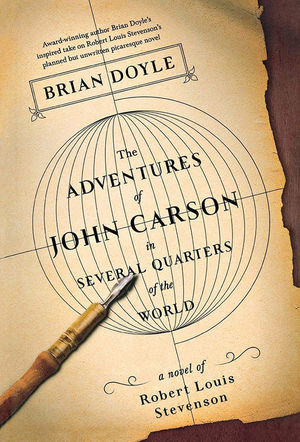
I read recently where a modern painter of no small accomplishment once said, “Whenever I see a Frans Hals, I feel like painting; whenever I see a Rembrandt, I feel like giving up.”
A writer of small accomplishment myself, I've often felt that way when reading Brian Doyle ’78, whose regular short essays and occasional longer pieces in Notre Dame Magazine surely made him our most frequent non-staff contributor of the last 30 years. Doyle’s writing was invariably a rushing, ebullient river of raw energy and grace, rippling with color, jazz (a favorite Doyle metaphor), stories and images that — at his best — he masterfully engineered in the service of divergent emotional effects.

To augment clumsily a very un-Doyle cliché: Brian could make me chuckle and tear-up in the same essay, whether he was writing about his boyhood scoutmaster, the death of his grandmother, or the on-court heroics of a wily, aging basketball player all too aware of the gathering twilight. Said better: Brian could make me want to put down my pen, but he could also make me long for God.
Last summer, when I decided to start reading the work of Catholic novelists, both for the pleasures of novel-reading that I was in danger of forgetting and in search of some insight into whatever a “Catholic” novel might be, I listed a few of Doyle’s late-career works alongside titles by Flannery O’Connor, John Kennedy Toole, Walker Percy, Graham Greene and G.K. Chesterton that I’d been meaning to read for decades — and found that I was as hot to read Doyle as these others. I suppose I was curious to see whether and how a seasoned essayist with such an unmistakable voice could stretch that magic from his customary 1,000 words into a few hundred pages of fiction.
Unsolicited, a friend lent me her copy of Chicago, so when Doyle’s turn came up on my list, I went with it first. I burned through it faster than anything I’ve read since my wife started birthing children: a hyper-observant and often hilarious novelized memoir of the year he spent living in Chicago and writing for U.S. Catholic magazine after his graduation from Notre Dame.
In this 2016 novel, Doyle is his own main character, and his self-characterization is spot-on, as perceptive and probing as are his memories of the fragrant empanadas his neighbor cooked in the basement of their apartment building and the mannerisms of the bus driver on his morning commute. Could the young, aspiring writer possibly have journaled so meticulously as to make a book like this possible 35 years later? Maybe. But a close second to Doyle’s leading protagonist is Edward, a sensitive and sophisticated dog who lives with the building’s superintendent, admires Abraham Lincoln, and seems capable of everything from community organizing to buying beers at a White Sox game — everything, that is, short of speaking something quotable in the narrative.
Whatever else Edward is doing in Chicago, his wanderings lengthen the leash tethering Doyle to anything like the hard-and-fast “truth.” The novel’s ambition is to be an epic-scale prose-poem distilled into 300 immensely entertaining pages, and they’re met. The storytelling is vast yet finely crafted, varied and unpredictable, the minor characters remain vivid in my memory and, as in all worthy epics from Homer to Thomas Hardy, the setting becomes a character in its own right, actively shaping the lives of its residents. Chicago’s music, food, churches, street scenes and circumstances set rich backdrops on the stage of people’s layered interactions.
A pair of breathtaking Graham Greene novels served also as parsley between my readings of Doyle. And I just finished The Adventures of John Carson in Several Quarters of the World, a worthy and intriguing work of historical fiction, published two short months before Doyle’s death at age 60 in May 2017. In a phrase, John Carson attempts to do for 1870s San Francisco what the author achieved on behalf of 1970s Chicago.

Doyle sure did his research for this one: Almost as much fun as the tale itself is his two-page preface that introduces this homage to his favorite author, Robert Louis Stevenson, not to mention the afterword that explains the book’s historical allusions and magically real modifications, and which cheekily assigns homework of a kind I’d be only too happy to do: Read the writings of Mark Twain, of Joseph Conrad, of the biologist and adventurer Alfred Russel Wallace, and of Stevenson, the novel’s narrator. All the great stuff Doyle “swam through” while warming up to write.
The history is simple. Stevenson lived in the San Francisco boarding house run by Mary and John Carson during the swift last months before his marriage. The fiction is fantastical: The real John Carson, about whom we know nothing else, not even the nature of his relationship with Mary, is here a Gilded Age Forrest Gump — not in the sense of intellectual limitations, but in his many connections to some rather conspicuous historical figures, starting with Stevenson himself. Many of these remarkable personages drop by the windswept, hilltop house on Bush Street to visit. A skillful sailor and hearty raconteur, Carson is old enough to have had notable shore adventures from Achill Island to Borneo to Vancouver to Australia, and young enough yet to be newly married and expecting a child while welcoming his famous friends to his fireside.
Among the visitors are the U.S. Army chaplain who blessed Carson and his fellow soldiers before the slaughter at Gettysburg, and — by way of the Carsons’ prodigious storytelling — the surly yet saintly doorkeeper at a Catholic school in Montreal, who brusquely welcomes a young Irish stowaway to the New World and sets her feet on a path of immeasurable importance.
Carson’s finest moment as an adventurer — and Doyle’s in this book — is his life-or-death game of chess with a warlord deep in the jungles of Sarawak. But I couldn’t help but feel that John Carson’s thunder had already started rolling out in the opening pages — not so much into the California mountains as out over the whitecaps of Lake Michigan. The voice and the charm — and above all the cadence — of both Carson and Robert Louis Stevenson are ultimately Brian Doyle’s. And that makes sense, given his affection and close identification with his subject. Doyle in 1979 was not much younger than Stevenson had been a century earlier; his all-hours perambulations of Chicago play the same narrative role that his writer-hero’s do in San Francisco.
In the end, both novels reverence the same conviction that animated so much of Doyle’s nonfiction: the sacramental power of story to heal, to justify and raise up our humanity. But where Chicago demonstrates this power, John Carson merely advocates it. I prefer the first of these two valedictories. Its narrative voice is direct and authentic, and Doyle is not limited by genre pressures to get more of his story straight. If its playful, ever-smiling depictions of historical figures and its lyrical glorifications of story make John Carson a Frans Hals, then Chicago for me is Doyle’s Rembrandt.
John Nagy is managing editor of this magazine.